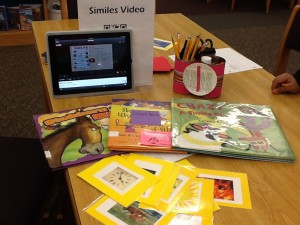
Students at the RBE Library have been learning about and playing with figurative language!
You might be asking yourself what is figurative language and why is it important for kids to understand?
Figurative language can make you look at the world differently because it heightens your senses and understanding. We read and hear figurative language every day. It’s important that students learn to recognize it and then analyze it so they understand what people mean when they use it or read it.
Figurative language often compares two things in such a way that you find the comparison interesting or even a bit surprising.
Our students got to move around 5 different stations to learn about and play with simile, metaphor, personification, hyperbole, and onomatopoeia. At each station they watched a video about each type of figurative language and then looked at figurative language in context in books. Then , they used some pictures at each station to try and create their own examples of figurative language.
Click Here to see the resources I used for the stations! Figurative Language Stations Activity Page and QR Codes for Stations
Fourth Grade Figurative Language Stations
Fifth Grade Figurative Language Stations

I love this idea! Do you have a lesson plan that you can share (sheets, videos, book list)?
Very helpful and interesting your activity with stations and figurative language. I want to adapto to my Spanish lesson for Heritage Learners. Thus could you help me with one issue: how do the students watch the video in each station in a room with other videos are being played? How did you solve that?
Hello Esther,
The students watched the videos at tables in the library that are all together. They watched the videos on laptops and iPads. The students are used to watching videos in the library while other students around them are also watching videos.